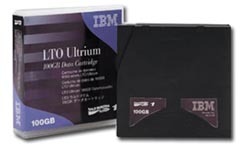LTO Tape
The Linear Tape-Open (LTO) was introduced by IBM, Seagate and Hewlett-Packard in 1998 as a powerful and scalable open tape architecture aimed at meeting the rising storage demands of contemporary servers. Brought forth as a means to supersede the Digital Linear Tape (DLT) format, up to 200 GB of capacity for data storage per cartridge was made possible at that time. The first generation of LTO tape stored data in 384 data tracks, which were divided into four data bands of 96 tracks each.
The four data bands would be bordered by bands of servo information written during tape manufacture. Data bands are filled one-at-a-time, in a linear fashion.
The two different implementations developed were Accelis and Ultrium.
The Accelis format, optimized for quicker data access, was accompanied by high reliability and good performance. It used two-reel cartridges with loading at the middle of the tape, resulting in lower access time. When this format was used, it was suited for automated environments and instant inquiry or data retrieval applications. However, technological advancements since it was first introduced resulted in sharply falling demand for the Accelis format. This is why the LTO program stopped providing specifications for this format and shifted its focus on the superior Ultrium format.
The Ultrium tape is suitably optimized for maintaining high capacity and good performance. It is highly reliable for either a stand-alone or an automated system. Added storage capacity is achieved by using a single reel cartridge which resembles the DLT tape format. There are suites available for backing up, restoring and archiving applications.
LTO Tape Generations
The LTO tape standard has a six generation roadmap for the Ultrium format. Each generation has had or is expected to have a 2:1 compression ratio for data storage. The table below has details for the first four generations which have been implemented already.
| LTO Tape Generation | Uncompressed Capacity | Total Number of Tracks | Data Transfer Rates (MB/second) |
|---|---|---|---|
| Generation 1 | 100GB | 384 | 40 |
| Generation 2 | 200GB | 512 | 80 |
| Generation 3 | 400GB | 704 | 160 |
| Generation 4 | 800GB | 896 | 240 |
Generation 5 and 6 have been projected as well. Generation 5 is expected to introduce a capacity of 3.2 TB with a data transfer speed of up to 360 MB/second with a compression of 2:1, and Generation 6 is expected to introduce a capacity of 6.4 TB with a data transfer speed of up to 540 MB/second with a compression of 2:1.

Key Benefits of LTO
- LTO has taken good advantage of available servo and head technologies that are essential for high track and areal recording densities.
- LTO brings about improved data compression and better run length limited (RLL) code. RLL is a method used to encode data into magnetic pulses.
- Dynamic rewrite of data written onto defective areas is possible with this technology.
- Dynamic halt to writing of data on regions of unreliable servo is available.
- LTO Cartridge Memory, denoted as LTO-CM, allows for fast data location. The LTO-CM has 4 KB of nonvolatile, solid-state memory.
- A Data Compression method called LTO-DC is specified in the LTO standard. It is also called Streaming Lossless Data Compression (SLDC) .
- There is precise indexing of recording units, which ultimately results in rapid data search and easy data recovery.


Comments - One Response to “LTO Tape”
Sorry but comments are closed at this time.